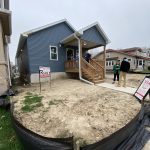Riverwest private dorm recommended for denial by City Plan Commission
Trinitas Ventures’ request for a change in zoning, from Industrial Light 2 to Detail Plan Development, was recommended for denial by the City Plan Commission at the February 6th, 2012 meeting. The proposal would allow for the development of a $35 million, 681-bedroom private dormitory to be developed on an existing industrial site, which has sat underutilized for numerous years. Trinitas Ventures targeted the Milwaukee area and this site in particular, because UWM has seen a 9% enrollment growth since 2005, approximately 26,000 students live off campus today, and UWM can currently only house 15% of their student population. The project would include 1.1 acres of green space, fully furnished units, tennis courts, a basketball court, a swimming pool, a workout room, shuttle service to campus, and other amenities aimed at attracting college students.
Brian Parish, Vice President of Brokerage Services for The Dickman Company, Inc. spoke in support of the project, and explained that they had been marketing the property since 2009, and that it has been available since 2002, but that we’ve “never concluded a sale or lease in this time”.
The project was opposed by neighborhood residents and at least two neighboring businesses. Tulip Corporation was concerned with the potential of receiving complaints from new residents, because Tulip Corporation has operations 24 hours a day and has always been located between industrial uses, not residential uses. Jonathon Eder, President of In Place Machining Company, spoke at length about the project stating it was critical to “keep it [the site] industrial”, and unless the city commits to its industrial zoning that it will “never attract another business”. Residents spoke about the impacts on parking, property values, noise, conflict with residents, a potential decrease in property values, and a potential increase in crime that could come about if the project was to move forward.
Alderwoman Coggs explained that despite only having $25 million worth of development in her district in recent years she was “in objection” to this project, and that her “position at this location will not change”. She listed a variety of reasons including the potential for students to be a target of crime, and that this project was inconsistent with the Northeast Side Area Plan.
Alderman Kovac also spoke in opposition to the project adding that “it’s a very high hurdle to change the zoning, and they haven’t even come close.”
The Commission voted unanimously to recommend denying the change in zoning, despite Trinitas Ventures’ request to hold the file.


















Disagree. We need some leaders to get out in front of issues and not pander to the few neighbors who object. Ugh
Jim; respectfully, I’ve sat in a number of neighborhood meetings regarding zoning changes and development proposals. While I would agree some neighbors are of the NIMBY or I don’t want any change in my neighborhood no matter what, you can usually sort out that kind of opposition rather quickly. They are the objector’s that have no alternative plan. Their plan is “NO!”
On the other hand, some of these developments may effect the quality of life in a neighborhood rather severely. Student housing is certainly one of them. Dorms, public or private, can be both good and bad for the immediate neighborhood. I often speculate, would the developers would live in a neighborhood they seek to develop?
I try to sympathize with the arguments against this, but find it very hard. At the end of the day, I just can’t wrap my head around the fact that all of the opponents of this project would rather see a mostly vacant eyesore and forego the opportunity cost of adding to the tax base and likely increasing property values of nearby homes (how could they decrease vs. what’s already there?). Am I crazy for feeling this way?
As a homeowner who lives within a block and a half of the proposed site, I wouldn’t classify the number of neighbors who are in opposition to this development as “few.” I’ve only encountered 2-3 people who are clearly in favor of the project (and who wouldn’t personally financially benefit from the proposal going through), and only one of them actually lives in north Riverwest. As such, I’m very pleased that Alders. Kovac and Coggs listened to the concerns of their constituents over the din of Trinitas marketing. At Monday’s meeting, when members of the CDC asked Trinitas simple but direct questions, like how they would handle conflicts between their residents and current RW homeowners, the Trinitas rep simply changed the subject. Their non-responses to even the most basic questions were very telling. Even MPD District 5 is in opposition to the proposal.
Over the past several weeks, I’ve done a great deal of research into Trinitas’ business practices and have come away with a very clear impression that for all the glitter and glitz their PR folks have thrown at us, they are simply not good neighbors to the communities in which they have developed properties. They want to build here because they think it’s cheap, and because they’re confident they can offload the property if they don’t get the 93% occupancy rate they require to maintain profitability, not because they have any kind of commitment to the neighborhood, city, or state. Their proposal specifically points out that this development would only create 10-15 permanent jobs. If they couldn’t make a buck here, they’d just pull up stakes, sell, and use the money to develop elsewhere.
Aside from the fact that Trinitas Ventures has sold 1/3 of their developments (the most recent one only two years after it was built) and have almost universally negative reviews from both tenants and the people in charge of the communities in which they’ve settled, they’re looking to charge *$850/month* for one-bedroom apartments a block away from the corner of Keefe and Holton, and $2500 for 4-bedrooms — without parking! All you need to do is take a quick glance at Craigslist to find apartments, flats, and even entire houses available to rent that both cost significantly less than that and are much closer to, or even directly on, campus. There is no shortage of existing student-friendly housing available in the immediate UWM area, not to mention Riverwest, and I just can’t imagine any scenario in which an industrial business park on the edge of Harambee could possibly be a location where nearly a thousand 18-to-26-year-olds would happily shell out around $600/month (and that’s the price with 3 roommates) to live… not to mention suburban parents who would be checking out the property for their kids. What is there for students to do nearby? Go to Walmart? It should also be noted that while Trinitas *markets* to college students, they will rent to anyone who can pay; the proposed development would be a public rooming house, not a dormitory.
My opinion is that this would be the wrong development by the wrong developer on the wrong site. I look forward to the day that a light industrial developer with a commitment to Milwaukee comes into our neighborhood, I commend the CPC’s decision, and I’m grateful to Urban Milwaukee for being such a consistent and reliable news source about issues like this.
@Stephanie (and everybody) thanks for sharing your thoughts on this one. And yes we just reported this one, but to me I think Monday was a day that CPC got two big projects backwards. I hope I’m wrong but I do believe this will be a vacant site for years and years to come, and I believe it is time we embrace students and UWM. And the other half CPC got wrong. MSOE’s garage. IWhat a bad deal.
Stephanie, what would be the right development?
Come on guys! Let this project roll!
@Dave Without Alderwoman Coggs, and Alderman Kovac on-board I don’t see this project getting past ZND….
Jesse, my neighbors and I would love to see development aligned with the Northeast Side Plan, which commits to maintaining the Keefe/Holton area as a light industrial corridor: http://city.milwaukee.gov/Plansandstudies/Northeast.htm
If the industrial park absolutely must be rezoned for residential use, development should be atttuned to the neighborhood, i.e. single-family dwellings, duplexes, and/or 4-unit apartment buildings, as opposed to one 700-bed megaplex. But I don’t think we need new/additional housing here, especially in light of the brand-new 36-unit Riverworks Lofts building on Holton and Townsend.
Embracing this development (or not) has nothing to do with students; Trinitas markets to students but rents to all comers. Moreover, it’s inaccurate to paint this as a Riverwest vs. UWM/students issue; again, the proposed development is not a “private dorm,” it’s a rooming house: nearly 450 of the 700 available beds will be in 4-bedroom units, and currently existing Trinitas sites have a 70%-100% resident turnover rate *every year* with 100% guaranteed turnover within 3 years. There is no connection or commitment between Trinitas and any university or educational entity in Milwaukee whatsoever. This development goes against both the Northeast Side Plan and UWM’s housing plan. The prospect of a sprawling complex with a huge, overwhelmingly transient population in an area with next to zero opportunities for recreation and/or new commercial business hasn’t inspired a great deal of confidence in our neighbors.
It’s abundantly clear that there is no lack of student-friendly housing available on campus. In December, UWM’s vice chancellor of university relations and communications said, “At this point, we really do not see the need for additional housing. We understand the Trinitas folks have said they are going to meet a need for additional student housing, but that need does not exist. We believe there is a significant amount of available space for students who choose to live off campus or in the immediate area.”
http://www.bizjournals.com/milwaukee/print-edition/2011/12/02/wanted-college-roommates—apartments.html?page=all
You can find proof to back up his assertion with a quick Craigslist search, even in the middle of February: http://bit.ly/wWP3sF (“UWM”) http://bit.ly/xOder9 (“East Side”) And that’s not counting vacancies in the many existing UWM-owned/operated buildings.
If this deal goes through, there is no guarantee that students (or anyone else) would live there: $850/month for a one-bedroom apartment with no parking, on the corner of Keefe and Holton? Would anyone posting here pay that? Considering you can get a 1BR in Shorewood for $100-200 less, it’s not exactly competitive for a neighborhood where it would be ill-advised to head very far west or south — or even north, up that long, dark stretch of Holton between Keefe and Capitol — on foot, especially at night, even more especially if you’re alone. Pricing and walkability aside, I have yet to encounter any hard evidence that this development would benefit our neighborhood in any way aside from filling up a vacant lot (or two; Trinitas has also proposed purchasing and rezoning another industrial lot so they can use it as parking overflow).
Yes, any new development in the entire city will add to the tax rolls. But is the power of a shiny new building considered to be so strong that it would be able to rezone and then reinvent what is currently a quiet, densely-populated residential neighborhood as a bustling center of commerce rife with opportunities for business and recreational expansion? Unless we knock all the factories and some of the houses down, Keefe is quite literally unable to develop into anything even remotely like North (or Center, or Locust, or even Burleigh), so I’m at a loss when it comes to figuring out how people have come to the conclusion that one privately-developed, privately-owned, privately-policed building has the potential to independently revitalize the surrounding area.
The village/city managers in locations where Trinitas has already built have said that no new businesses or neighborhood improvements have occurred as a result of the developments, but did point out that there are still complaints about noise, parking, and crime from both neighbors and Trinitas property residents. The Keefe Avenue project is the first non-campus urban development that Trinitas has proposed. Is there a reason that the increases in noise and crime levels that have resulted from Trinitas developments in suburban and rural areas would be *less* likely in an urban environment? Particularly in District 5?
Finally, it’s been somewhat unsettling to see that nearly everyone on the pro-development side either clearly or admittedly doesn’t live in the neighborhood and/or stands to (or believes they will) personally financially benefit from it.
It seems that most people who are in favor of this proposal would prefer that north Riverwest homeowners simply fall to our knees and welcome Trinitas with open arms, overwhelmed with gratitude that someone, ANYONE would choose our blighted neighborhood as the site of an obviously overpriced gated settlement designed to run through nearly a thousand 20-somethings every year. Why? Looking at their track record makes it clear that the lasting effects this development would have on the neighborhood are likely to skew negative, and if they had to lower prices to match market rents and thus cut into their profits, there’s nothing stopping Trinitas from selling to yet another unknown private corporation, as they’ve already done with 2 of their 6 properties.
It’s much easier to want a proposal like this to pass when none of it will affect you, your property values, your crime levels, your peace and quiet, or your home, so here are some reviews of Trinitas properties…
http://bit.ly/wQQkiL
http://bit.ly/yEAwfJ
http://bit.ly/ypoC87
http://bit.ly/zcScoN
http://bit.ly/y8SJ5C
If that all sounds like something you’d want in *your* backyard, please feel free to invite them to re-propose this development in your neighborhood. 😉 Sorry for rambling; I just haven’t seen as much evidence-based positioning as I’d hoped to see around this issue, and the wholly subjective “build build build!” sentiment doesn’t do much for me.
Stephanie, I really enjoyed reading your posts. It definitely helps me see this from the other point of view, thank you. There’s clearly a lot of things to consider with this proposal that make me second-guess my support for it.
Hi Stephanie,
It’s good to see you lay out a little bit of what you’re for, rather just what you’re against. I grew up & made my home in Riverwest for many years, I’ve seen the reactionary attitudes that so many have had regarding any change.
I’m not lumping you in with that.
I don’t think industrial uses should be the only option for the area north of Keefe, it’s great there are industrial firms doing well, but that doesn’t mean that some of the long-vacant space in the area can’t be repurposed. If this project were something like 2040 Lofts on WI Ave near Marquette, where only students can rent, this would be better. If they did this project in phases, where additional approvals were required to expand, this would be better. If this was closer to more transit, existing neighborhood businesses… it would be better.
I share a concern that if the student demand for living space isn’t there, they will just fill the building with anyone. I’ve dealt with bad tenants/neighbors & their enabling landlords… it doesn’t serve a city or neighborhood to create more of that.
Stephanie,
People are inherently afraid of change. When someone suggests their insights prove a company that has successfully developed several multimillion dollar developments in niche markets is wrong, that suggests they are operating a bit outside of reason.
I understand the neighbors’ concerns. The real fault of this situation lies on the city for not providing the leadership or planning expertise to explain to the neighbors how they would benefit from the project or the overall cost of denying the rezoning.
When I first saw the proposal when introduced at the Holton Youth Center I formulated a lot of ideas, but my experience in development is limited so I stepped back and starting asking people that work actively in urban planning for questions and examples and I looked at similar projects and drove to see them and look and listen. I walked away with a much better understanding. We have great example here in Milwaukee. Look at the Cambridge Commons, or any of a multitude of other projects Milwaukee has in industrial areas. It is surprising the effect that a well designed project can have in areas like this.
When all is said and done what happened
A private land owner was denied the ability to sell his land
A private company was denied an opportunity to develop their project
Neighbors lost an opportunity to remove a blighted property
Businesses lost the opportunity for new customers
500,000 in tax money
Well then who won?
A city government that is obtrusive and stifles growth
Neighbors that are afraid of change
This project has come and gone, but I think the important realization is how much the DCD has changed.
http://www.insidemilwaukee.com/Article/242011-MilwaukeeLacksaDesignVisionary
@Chris To be fair there is a vision, a plan which involved numerous community stakeholders to put together for that area, and it doesn’t include residential on that land. Further, it’s not like the property owner wasn’t aware of that as I’m sure it has been zoned Industrial for a very long time. So if anything the city did what it was supposed to do and followed the plan.
@Peter & Jesse — Thanks for the thoughtful comments.
Aside from industrial facilities, some additional ways to use either this specific site or the outmoded vacant buildings in the area might include an employment/temp agency; a business incubator; a community/youth center; repurposing some buildings and parceling them out into studios for artists and bands to work and practice, like Sydney Hih; limited-income artists’ lofts, like Kunzelmann-Esser on Mitchell Street; a community garden with rental plots (a practical impossibility, given that the entire area is likely or confirmed brownfields, but hey, it’s nice to dream); or an above-ground urban agriculture site, like Sweet Water Organics or Growing Power.
I think there’s a great deal of commercial potential south on Holton, especially the the Lena’s/Community Foods property, but I’m not quite sure how to get there from here. I’m hoping that the Riverworks Lofts opening will help spruce up the block and help nudge that property toward becoming a self-sustaining grocery store. It would be great if we could get one or two spots zoned for commercial on Keefe, so we could have a small neighborhood restaurant or coffee shop, but again, the fruition of that potential is pretty far from where we’re at today. There have been some rumblings that someone may have purchased the old Albanese’s site, but from what I had heard prior to that, the asking price is/was precipitously high for a building in such dire need of extensive repair.
FYI, the Riverworks section of the Northeast Side Area Plan is outlined on pages 148-152 of this PDF; the Holton Street Corridor plan is on pages 175 and 178 — some excellent (albeit light) reading if you’re interested in the upkeep of the area: http://city.milwaukee.gov/ImageLibrary/Groups/cityDCD/planning/plans/Northeast/plan/NECh5to11.pdf
And here is Riverworks Center’s Design Guidelines, with a great suggestion to spiff up the intersection of Holton and Keefe on page 8: http://www.riverworksmke.org/bid25/documents/RDCDesignGuidelines_Final.pdf
@Chris —
Other than the fact that they’re both designed to contain roughly 700 people, comparing projects like UWM’s Cambridge Commons to Trinitas’ proposal for Keefe is largely apples and oranges. The most important differences, IMO, are 1) CC was specifically built for, has its vacancies directly filled, and is policed/controlled by UWM, which all combine to guarantee both consistent upkeep and consistent demand, and 2) CC was constructed on North Avenue, which has been a major commercial corridor for.. well, longer than I’ve been alive. Across the street from CC are a bar and a tattoo parlor, behind it is a cardboard recycling facility, around it is more UWM student housing, many commercial spaces (both vacant and occupied), and the Milwaukee River. On the other hand, Keefe has all single-family homes and duplexes on one side and all industrial facilities on the other, no other student-oriented housing complexes anywhere nearby, and effectively zero recreational facilities/bars/shops/cafes or opportunities for commercial expansion in the immediate vicinity, unless you count Peace Action or the piano repair shop.
“When someone suggests their insights prove a company that has successfully developed several multimillion dollar developments in niche markets is wrong, that suggests they are operating a bit outside of reason.”
Seconding Dave here: the DCD’s decision simply maintains the Northeast Side Area Plan, which I had linked above. Riverworks, the Common Council, and many other community stakeholders can hardly be dismissed out of hand — I’m confident that those entities know our neighborhood at least slightly better than Trinitas, and that more than a few months were spent and more than a few dollars were outlaid in the development of the NESAP.
When someone suggests that the NESAP, which was created using the combined insights of the DCD, Riverworks, CC, etc., should be abandoned as soon as a private company rolls into town waving a bunch of money around, and goes on to imply that the company must know what’s best for north Riverwest because after all, they have the ability to wave a bunch of money around… to me, that suggests they are operating a bit outside of reason.
You’re absolutely free to insist that one of the grounds upon which this proposal was denied was us whinging NIMBYs being so terrified of growth/change that we are utterly lacking in foresight, but here at ‘ground zero,’ that attitude has barely made a peep in the many exchanges I’ve had with my neighbors. The overwhelming majority of the people I’ve spoken to are absolutely in favor of development; we just want the *right* development. This could include continuing to solicit for light industrial, any of the other possible suggestions outlined above… or almost anything, really, except a massive apartment complex designed to introduce and promptly wave goodbye to 500-700 people every year. A lot of people have touted the benefit of adding to the city tax rolls, but no one ever provided a truly compelling reason as to why the 634 E. Keefe site was a resoundingly and mutually beneficial choice for a building like this, aside from “it’s cheap, it’s available, and it’s within 2 miles of UWM.”
What Trinitas proposed would have necessarily and permanently changed the crime levels, property values, population density, character, and “feel” of north Riverwest; since they are an unknown quantity in Wisconsin, there is no evidence to suggest those changes would have been for the better. Regardless, plunking a 700-bed complex on a quiet thoroughfare in a quiet neighborhood would be asking an awful lot of both current and potential residents. It’s not difficult to see that there’s a pretty big difference between not wanting to add a sprawling apartment complex housing close to a thousand transient residents to an otherwise low-key street and being “afraid of change.” If you’ve read all the reviews of Trinitas properties from tenants and village/city managers and you still want them to build here, assuming you live in Milwaukee proper, you can certainly ask them to scope out available properties on your street or in your neighborhood.
I understand that many folks are upset about the loss in potential property tax revenue, but insisting this project could have been developed to guarantee mostly neutrality or positive change in the neighborhood, let alone that it could have turned Keefe Avenue into even a minor player on the commercial/recreational circuit — that all sounds nice on paper, but in practice, it’s little more than wishful thinking.
Notwithstanding the protestations to the contrary, Chris has got this just about right. I would add to his list, however, a material measure of the parochialism for which Milwaukee is so well known. Or perhaps there is somebody here who can explain why the state of the developer’s corporate residence really matters? Does it really carry any truck with anybody that Trinitas is from Indiana? I hope, for our own sad sakes, that it does not.
If it does, though, then why haven’t Cambridge Commons and Riverview performed brilliantly? Both were chock full of the usual suspects getting their beaks wet. Mandel got a taste; Grunau got a taste; and so on, and so on. If you step back and look at both projects, however, what you see are ill-conceived and under-amenitized projects that not even the long, compulsory arm of the University Housing office can salvage. In fact, the Cambridge Commons site was both IL2 AND fully taxable (and tax-producing) at the time of its transfer to Mandel. So why should that model be replicated? Can anybody explain, soberly, either the economy or the moral virtue of taking a fully-taxable piece of industrial land and (i) converting it to an exempt use and (ii) improving it with publicly financed debt obligations that will continue to hamstring a Regents system already swimming in facilities debt? And this constitutes a valid comparison t to the Riverwest project . . . how? Or was the real concern that the Trinitas development, by providing a long list of services and attractions that UWM dormitories do NOT might further erode the subscription levels of the North Avenue dorms–poorly planned and poorly placed projects that will be siphoning the public purse for more than another two decades?
A certain number of the comments here keep little company with the facts. One easy example: Average per-bed rents for the Trinitas development projected at $550/month, not $850/month, and included services (utilities, cable, data) that are rarely found in the Shorewood multifamilies. It’s also worth noting that this developer has considerable experience in developing, leasing, operating, and pricing multifamily housing that targets students. Why is it that armchair developers who wouldn’t know a pro forma from a probiscus feel entitled to speak piously about what “the market” will and will not bear–and, absurdly, to do so in the face of folks who are willing to stake $35 million of their own funds on the wager.
As for Riverworks, here’s about all I need to know. In 2010, the assessments of every last non-retail, non-residential parcel east of the tracks and south of Capitol AGGREGATED to less than $20 million. Otherwise said, the City had an opportunity, with one project, to more than DOUBLE this valuation, and to do it for the price of a single derelict building. That, in my view–while absolutely not perfect–amply satisfies any call for a “resounding” or a “compelling” justification for approving this project.
You should recall that SB Friedman of Chicago–one of the country’s leading development advisory firms (but immediately suspect to some, I suppose, since not a Cheesehead)–prepared a report for MEDC in May 2004 entitled “Milwaukee’s Industrial Land Base: An Analysis of Demand and A Strategy for Future Development” (May 2004). Several folks referred to this report in the course of public comments on the Trinitas proposal. What ALL of them missed, however–and what the City’s own staff was too duplicitous to observe–is that the Friedman report includes a conclusion that speaks directly to this situation (p.60): “Obsolete industrial sites should be allowed to convert to other productive uses. Because the conversion of obsolete industrial properties offers real economic and social value to the City, sites which are less marketable for industry or compatible business development should be allowed to convert to retail, residential, or other uses.”
Can there be ANYONE who watched this process play out who does not believe that the Coakley site ISN”T “obsolete.” Its occupancy hasn’t pushed past 10% occupied for more than a decade. Coakley himself can’t rent it for anything but bulk storage of unpackaged materials. In fact, the assessment really tells the whole story. In 2010 it was barely $4/square foot.
So let’s be plain: Where the future of Riverworks is concerned, the Northeast Side Plan is far more a work of sheer fiction than it is a revealed truth. (I’m sure this will shock–SHOCK–those who evidently feel that competent economic development exists to give voice to the demos.) This area has been openly and notoriously in decline since the day that Chrysler shuttered the Seaman body plant AND IT IS NOT COMING BACK AS A LOCUS OF INDUSTRIAL ACTIVITY. The City can deny its focus all it wishes, but it has placed big bets on Menomonee Valley, on Century City (see the JS op-ed piece and the interview with Rocky Marcoux from Sunday’s paper), and on 30th Street Industrial Corridor (where will the President be visiting again? In-Place Machining?)
In the meantime, the City, its mulish leadership, and a NIMBY enclave have managed to drive off taxable, privately-financed development of more than $30 million. At current ad valorem tax rates, the present value of the property tax revenues alone woudl amount to nearly $7.5 million over the next decade But, hey, not to worry: I’m sure that Chris Coakley will continue to pay his $17,500/year each and every year for the next 10, and at the end of that time the City will have enough money to–well, at least to replace one of those neat Riverworks signs.
@Eastsider Just one point of clarification. Although Cambridge Commons is a tax exempt property it does make PILOTS, so it does contribute. (though this could end if push came to shove).
@Eastsider Let me add a little more. I believe the point people are making in regards to the out of state developer in this case is that this is a large facility that will house lots of students. So they fear there will be little response to the neighborhood if there are issue, which are possible. Whereas the UWM buildings have UWM for neighborhoods to complain to.
@DaveReid. Good point, and true enough. Although the rate on the PILOT is generally about $7 per thousand, which is perhaps 25-30% of the full assessment burden. And, of course, the payments are strictly voluntary.
As for oversight, I must say that I’m not all that convinced. Perhaps I spend too many Friday and Saturday nights taking walks up and down Shepard and Summit and Hackett and Stowell and Murray, where the virtues of private (and, one presumes, principally local, and conceptually accessible) ownership seems to do remarkably little to constrain conduct that ranges from innocent shenanigan to downright felonious in the disorganized mish-mash of ramshackle structures that house so much of the university student body. Frankly, I would rather, as a neighbor, have a private owner running a single-purpose housing facility with a sizeable on-site staff whose JOB is to keep the peace–supplemented by both private security and a small force (as Trinitas had proposed) of resident City police oficers.
By the way, don’t take my word for any of this. Consider folks who have first-hand experience. One good example is Madison mayor Paul Soglin, who wrote a piece (http://www.waxingamerica.com/2007/12/mifflin-street.html) a few years back about the solution to “the Mifflin Street problem” in Madison. His solutions–which Madison has been pursuing with some success–are (1) find sites for the private sector to build student-oriented housing for upperclass and graduate students and (2) phase out multifamily zoning in the areas of predominant single-family use near campus. I don’t always agree with Paul Soglin, but he’s dead right here.
So, if somebody has 8-9 shovel-ready acres east of the river, south of Capitol, and north of North Ave, speak up; the City knows the name of a developer with 35 million burning a hole in its pocket. (And please don’t quote the cluck in the JS commentary who suggested that Trinitas build its dorm on the golf course in Lake Park.)